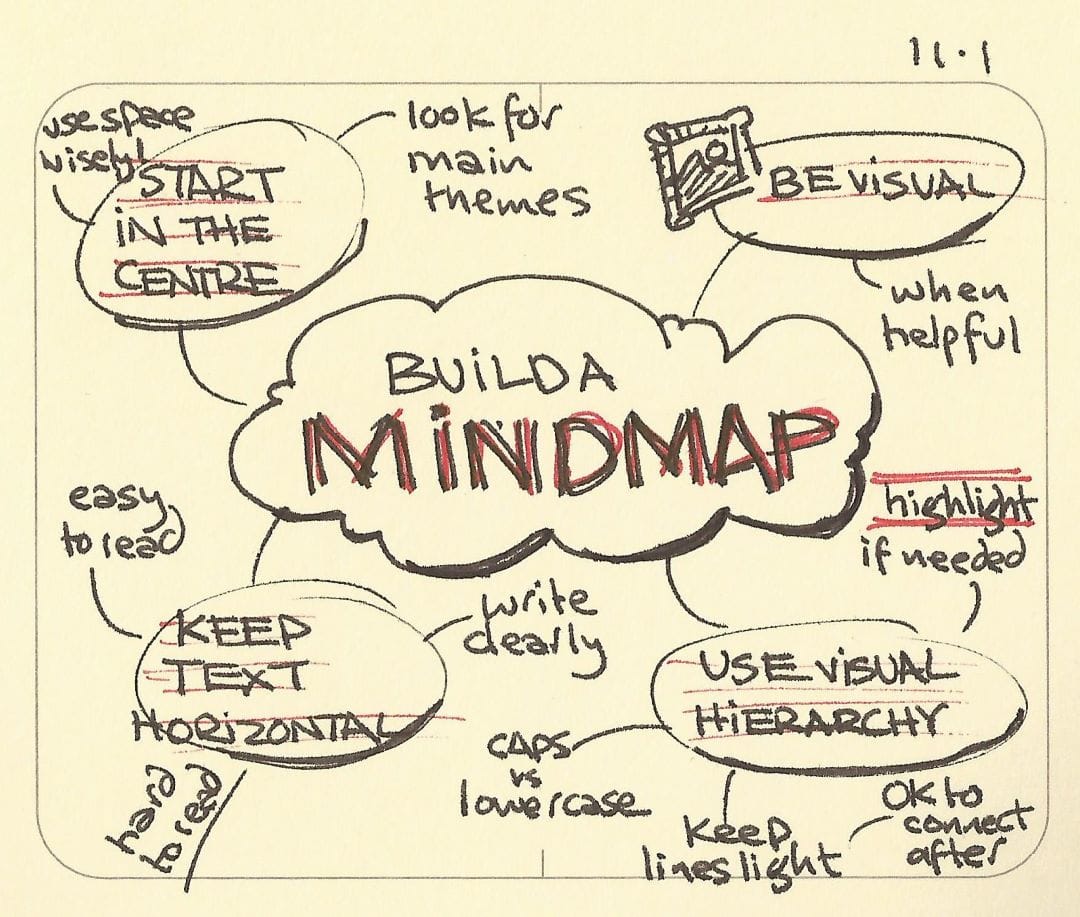Mind Map is a powerful visual tool that helps organize information, inspire creativity, and improve productivity. With various mind-mapping techniques suited to specific tasks, choosing the right style can make a huge difference in brainstorming, planning, and learning.
In this guide, we’ll explore different types of mind maps, their structures, and best use cases to help you maximize the benefits of each format.

1. Hierarchical Mind Maps
Structure: Hierarchical mind maps have a top-down layout, where the main idea sits at the top, branching downward into more detailed subtopics. This approach creates a clear, linear mind mapstructure and layout that’s easy to follow.
Best Use Cases: This format is ideal for organizing project planning tasks, studying topics with multiple layers (e.g., history, biology), or setting long-term goals. Hierarchical mind maps are also effective for visual thinking with mind maps when clarity and order are priorities.
Example: Imagine planning a research project. Start with the project’s title at the top, then branch into sections like “Literature Review,” “Methodology,” and “Conclusion,” with each section further divided into smaller, relevant details.
Illustration: A hierarchical mind map example for “Project Management,” where “Project Management” is at the top, branching into “Planning,” “Execution,” and “Evaluation,” each of which has additional sub-branches like “Tasks,” “Team Members,” and “Deadlines.”
Visual Tip: Use different colors to distinguish branches and layers, helping to navigate between different sections quickly.
2. Flowchart Mind Maps
Structure: Flowchart mind maps use boxes or shapes in a sequential flow, connected by arrows that indicate the progression of ideas or steps.
Best Use Cases: Flowcharts are perfect for mapping processes, decision-making, troubleshooting, and outlining workflows, making them suitable for business processes or detailed task organization. Flowchart mind maps work exceptionally well in mind mapping for business environments.
Example: For a product launch plan, start with “Initial Research” and map out steps like “Design Prototype,” “Market Testing,” “Launch,” and “Feedback Collection.” The logical, step-by-step flow makes it easy to follow each stage of the project.
Illustration: A flowchart mind map example for a “Customer Support Process,” starting with “Receive Inquiry” and branching into “Analyze Problem,” “Provide Solution,” and finally, “Follow Up,” with arrows showing the order of operations.
Visual Tip: Use icons and arrows to clearly distinguish each step and make the flow of information smooth.
3. Spider Diagrams
Structure: Spider diagrams have a radial structure with a central concept at the core, branching outwards like a web. Each branch represents a subtopic, allowing for free-form brainstorming and idea generation.
Best Use Cases: Ideal for brainstorming sessions, idea generation, and mapping complex central concepts, spider diagrams encourage creative mind mapping ideas and free thought, which is helpful in content creation, for example.
Example: Planning blog content, with “Blog Topics” at the center. Branches could include “Technology,” “Lifestyle,” “Health,” and “Finance,” with each branch broken down into specific topics, supporting content organization with mind maps.
Illustration: A spider diagram example focused on “Digital Marketing Strategies,” with branches labeled “Social Media,” “SEO,” “Content Marketing,” and “Email Campaigns,” each containing further details.
Visual Tip: Use colors to differentiate branches, making ideas more visually engaging and the entire map easier to read.
4. Bubble Maps
Structure: Bubble maps feature a central bubble with surrounding bubbles connected by lines. Each bubble represents an attribute or subtopic, effectively categorizing characteristics.
Best Use Cases: Bubble maps are excellent for categorizing concepts, such as comparing attributes or organizing details of a central idea. They’re a favorite for describing attributes or creating a comparison mind map for products or ideas.
Example: Studying a novel, with the title in the center, connected to bubbles representing “Plot,” “Characters,” “Setting,” and “Themes.” Each can have additional bubbles to elaborate further.
Illustration: A bubble map example on “Project Success Factors,” with surrounding bubbles like “Budget,” “Teamwork,” “Timeline,” and “Resources,” and each bubble breaking down into sub-attributes.
Visual Tip: Assign colors and icons to each bubble for quick differentiation, ensuring the map is easy to understand at a glance.
5. Concept Maps
Structure: Concept maps are web-like structures that connect related ideas, showing relationships through linking phrases or words.
Best Use Cases: These maps are ideal for research, exploring relationships, and tackling complex topics with interconnected elements, such as academic research, strategic planning, or complex project mapping.
Example: A concept map for environmental science, with “Pollution” connected to “Air Quality,” “Water Quality,” and “Climate Change,” showing how each factor interrelates.
Illustration: A concept map focused on “Global Warming,” with connections to “Greenhouse Gases,” “Deforestation,” “Ice Melt,” and “Rising Sea Levels,” showing how each affects the other.
Visual Tip: Use linking phrases like “leads to” or “influences” to clarify connections between ideas, making the map easy to interpret.
6. Multidimensional Maps (3D Mind Maps)
Structure: Multidimensional maps add a third dimension, creating maps that can be rotated and explored from different angles using software tools.
Best Use Cases: For deep research and complex analysis, multidimensional maps are invaluable, as they allow you to analyze various levels of information simultaneously, making them perfect for in-depth business analysis, supply chain planning, and advanced mind mapping for productivity.
Example: A 3D mind map on “Global Supply Chains,” with layers representing “Logistics,” “Demand and Supply,” and “Risk Management,” allowing for exploration of each area.
Illustration: A 3D map for “Corporate Strategy” with dimensions for “Growth,” “Competitiveness,” and “Sustainability,” each linked to additional layers and details.
Visual Tip: Use software like XMind or MindManager to create a 3D view, which helps when examining intricate relationships across multiple dimensions.
Choosing the Right Mind Map: A Quick Guide
| Mind Map Type | Best Use Case | Key Features |
| Hierarchical Mind Map | Project planning, goal setting | Top-down structure, layered levels |
| Flowchart Mind Map | Process mapping, decision-making | Sequential steps, arrows |
| Spider Diagram | Brainstorming, idea generation | Radial structure, central concept focus |
| Bubble Map | Categorizing, comparison | Central bubble with surrounding attributes |
| Concept Map | Research, relationships | Web-like uses linking phrases |
| 3D Multidimensional Map | Complex analysis, in-depth research | 3D layers, software-enhanced visualization |
As you explore the different types of mind maps in this post, you might also be interested in diving deeper into how mind mapping can transform your creative thinking.
Check out my detailed guide on Mind Mapping: Transform Your Thinking and Boost Creativity to unlock powerful tips and techniques that can help you harness this tool for enhanced productivity and innovation
Also, Watch: How to Mind Map with Tony Buzan
Conclusion: Optimizing Your Mind Mapping Experience
Mind mapping is a versatile tool, and each type of map offers distinct advantages tailored to specific tasks. For well-organized projects or clear, structured thinking, hierarchical and flowchart maps work best. Spider diagrams and bubble maps are ideal for brainstorming and categorizing, while concept maps and 3D maps are perfect for deep research and complex analyses.
By selecting the right type of mind map for your needs, you can optimize mind mapping for productivity, make learning more engaging, and encourage creativity. Whether you’re planning a project, generating new ideas, or tackling complex subjects, there’s a mind map format that can help you map your way to greater clarity and insight.


Leave a Reply